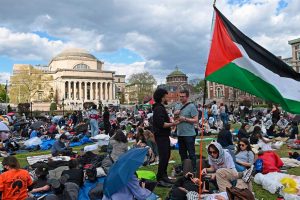Rhodes and co-defendants Jessica Watkins, Kelly Meggs, Thomas Caldwell, and Kenneth Harrelson have stood on trial for seven weeks as the Justice Department has worked to convince jurors of that “truth.”
Through the Oath Keepers’ own words at meetings and in thousands of text messages; in underground garages or while traveling across the country, from November through January 2021, prosecutors say the defendants had every intent to stop a tradition in the United States that has been unbroken for two centuries.
“They explained how they wanted to join together to do whatever was necessary to prevent Joe Biden from becoming President,” Nestler said.
The Oath Keepers saw Jan. 6 as an “opportunity” and “seized it” after amassing weapons from all four corners of the United States and attempting to recruit as many willing participants as they could.
“It is that simple,” Nestler said.
The Oath Keepers defense has relied chiefly on the claim that there was never an explicit plot or plan to attack the Capitol on Jan. 6. Nor, they have argued, was there a plan to stop the certification of the joint session of Congress or now-President Joe Biden’s inauguration on Jan. 20, 2021.
As closing arguments were presented Monday for defendants Jessica Watkins, Thomas Caldwell, and Kenneth Harrelson, emphasis was again heavily placed on this premise. But with no time to waste, it was also coupled with yet more allegations of impropriety by the Justice Department and FBI and aspersions cast on the credibility of the evidence. (It is worth noting the evidence was authenticated and agreed upon by all parties before the trial convened.)
When jurors meet on Tuesday morning to begin deliberations, they will have an unquestionably formidable task before them.
Nestler told the jury that in order to sort out whether the defendants are guilty of seditious conspiracy beyond a reasonable doubt, they must understand: they do not have to establish there was a concrete plan.
The defense’s reiteration to this point has been a “colossal waste of time,” Nestleradded.
To find the defendants guilty, the jury must establish whether there was a mutual understanding or agreement.
“That’s what a conspiracy is,” Nestler said before quickly reminding jurors that it was Jessica Watkins who barked into her walkie-talkie on Jan. 6 that she was “sticking to the plan” while storming the Capitol.
Further, to prove guilt, the government is not required to show that conspirators had a written or oral agreement nor does the government need to prove that the conspirators were aware of every detail or even agreed about every detail of a conspiracy.
“To be clear, the evidence has shown you the defendants did have an express agreement. An express agreement to oppose by force if necessary the lawful transfer of power. But you can find these defendants guilty without even finding an explicit agreement, implicit will also suffice,” he said.
Prosecutors say Rhodes directed Oath Keepers from outside of the Capitol on Jan. 6, moving from one side of the complex to another to survey his foot soldiers’ movements and report information and updates back to Oath Keepers via phone or through the encrypted texting app, Signal.
Defendants Watkins, Meggs, and Harrelson went inside the Capitol on Jan. 6 as part of a larger “stack” formation of Oath Keepers before splitting off once in the rotunda. Watkins, who admitted to felony civil disorder on the stand last week, went “looking for Senators” Nestler said Tuesday. Meggs, according to his own text, said he was looking for then-Speaker of the House Nancy Pelosi. Once he was inside, Meggs spent most of his time near Pelosi’s office and it was there that he interacted with the overrun but quick-thinking U.S. Capitol Police Officer Harry Dunn.
As Harrelson breached the Capitol, he screamed “treason!” with Oath Keeper Jason Dolan to intimidate congresspeople. Dolan has already pleaded guilty and has already told jurors that he was willing to take up arms against the government. Thomas Caldwell, who recorded himself and his wife Sharon Caldwell on the lower west terrace and the inaugural stage, sent updates about the breach while it was happening, and long before then, prosecutors say, he coordinated attempts to secure a boat intended to ferry weapons into Washington, D.C. from nearby northern Virginia.
That boat never came to pass but the Oath Keepers did bring a huge arsenal of weapons to a hotel in Arlington, Virginia anyway. The group dubbed this arrangement in countless texts as its “quick reaction force” or a QRF.
At trial, Rhodes sought to play the QRF down, saying it was only there in case Trump invoked the Insurrection Act and he would need Oath Keepers on “standby” to defend him or the White House. At the same time, he largely denied having any direct involvement with it. But in a covert meeting with Jason Alpers, a military veteran who told jurors he had “indirect” ties to Trump, Rhodes told Alpers in November 2020 that “the QRF will be awaiting the president’s orders.”
“That’s our official position. And the reason why we have to do it that way is because that gives you legal cover,” Rhodes said on Nov. 9.
Rhodes also said in that video: “Fight against the government no matter what.”
“Legal cover,” according to the Justice Department, is precisely what Oath Keepers deployed at trial while claiming they were merely conducting personal security details on Jan. 6 for Trump VIPs like Roger Stone or Michael Flynn. Other names, Nestler noted, were mysteriously difficult for Rhodes, Watkins, or Caldwell to recall when testifying.
Texts show Rhodes called on Oath Keepers to come to the Capitol during the breach on Jan. 6 while Oath Keepers were allegedly serving on “security details.”
Meggs also called on Oath Keepers to join him at the Capitol.
“If you’re protecting a human being, do you bring them to a riot? Or lead them away from a riot…Even if they were a personal security detail, they had another intent. To stop Congress. And they did. They can still be found guilty,” Nestler said.
Both the prosecution and the defense rested last week and Nestler’s remarks on Monday served as the government’s searing rebuttal. Of the five defendants, Rhodes, Watkins, and Caldwell testified. Meggs and Harrelson opted against it.
The decision to testify was unequivocally risky.
Rhodes was frequently arrogant while testifying and he tripped over key details. Caldwell’s testimony was riddled with conflicting information and like Rhodes, Caldwell’s tone was often defiant once confronted.
Watkins was perhaps the most sympathetic and compelling witness to testify, offering jurors repeated apologies for being another “idiot running around in the Capitol” on Jan. 6 and explaining her actions as a product of many trauma-filled years at home and later, struggles with her transgender identity.
When Nestler addressed Watkins’ “remorse,” he told jurors to look on her with a deeply skeptical eye.
The only evidence of her remorse for her conduct was her “self-serving testimony now that she faces accountability.” Nestler said.
“They took matters out of the hands of the people and put rifles into their own hands. They claimed to be “oath keepers.” They did not live up to that creed. They claim to wrap themselves in the Constitution. They trampled it instead. They claimed to be saving the Republic but they fractured it instead,” Nestler said.
Jurors will begin to deliberate on Tuesday and then break for the Thanksgiving holiday from Wednesday to Friday. They will then return Monday to continue deliberations.
U.S. District Judge Amit Mehta took a moment to offer his final thoughts to all of the attorneys after the sprawling case finally went to the jurors.
“If the American people are looking for an example of how our institutions work, how our democracy works, how our criminal justice system operates, we have no better example than this case,” Mehta said. “The lawyers on both sides of this case, notwithstanding the high stakes, the novel principles, and the volume of evidence for months and months and months demonstrated nothing but the highest degree of professionalism.”
He added: “I’ve been honored to preside over this trial with all of you here. Frankly, you have done more to show people how this country runs… in ways that frankly, I don’t think you can appreciate.”
The last time the Department of Justice secured a conviction for sedition was 1995. Jurors found Omar Abdel Rahman, also known as The Blind Sheikh, guilty of seditious conspiracy along with nine others for their role in the 1993 World Trade Center Bombing.
If you want a blow-by-blow of today’s closing day, check out the Daily Kos live-blog or the mega-thread on Twitter below. If you want more info on jury instructions, it’s in the thread as well as in the blog, but here’s a link for your convenience.



